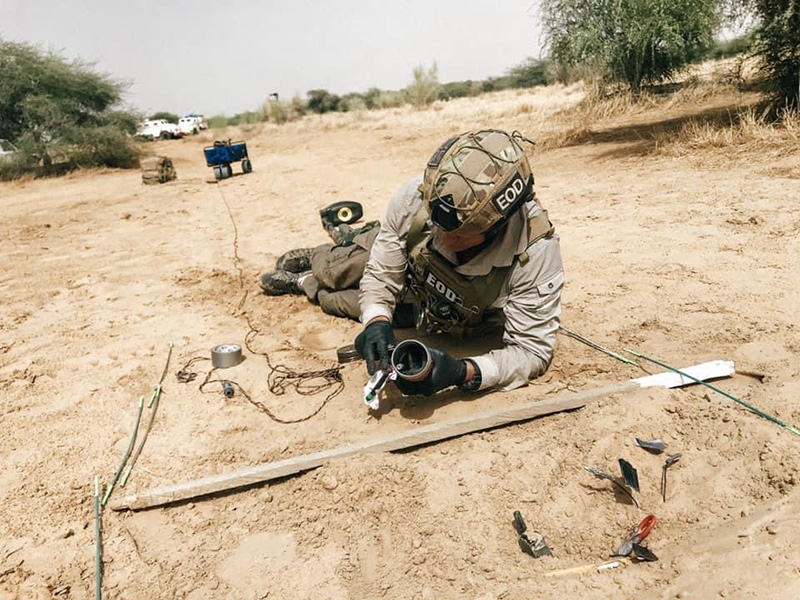London City Airport bomb clearance
Survey and clearance of King George V Dock to enable London City Airport expansions.
London City Airport (LCY) was seeking to expand the current terminal facilities, aircraft stands and taxiway of the airport when it commissioned SafeLane Global to assist.
To fulfil the proposed works, part of the terminal and baggage building extension would be situated on a new concrete deck built on piles, to be located across the dock bed of King George V Dock.
SafeLane Global was employed to survey and clear the dock - resulting in the find of 500kg unexploded German bomb.
History of King George V Dock
The King George V Dock was built in 1921 and was a major cargo dock, supplying the City of London with goods from all over the world.
As the second world war began, the Luftwaffe (German airforce) targeted major infrastructure sites, such as the King George V Dock. These sites were bombed in an attempt to disrupt the supply of goods and the transportation of war materials.
In addition to this, the Luftwaffe used the Thames as a means of navigation into the city - and due to the close proximity of the King George V Dock to the Thames, this meant that on some occasions the Dock was bombed inadvertently when the Luftwaffe were attempting to hit other targets of interest.
Surveying King George V Dock
As part of the works carried out by London City Airport (LCY), an unexploded ordnance desktop study covering the airport campus was commissioned from SafeLane Global.
Following an unexploded ordnance (UXO) desktop survey, a high risk of UXOs within the footprint of the proposed development was identified.
LCY approached SafeLane Global to provide a proposal to conduct UXO survey and investigation works across the site in order to mitigate the risk.
The scope of works requested by the client fell into three distinct operations:
- The non-intrusive survey of the site footprint.
- The investigation and clearance of potential UXO targets.
- The removal of obstructions ahead of piling activities.
The non-intrusive marine survey
The survey was undertaken using geophysical survey methods across the extent of the site footprint. The geophysical methods employed magnetometry, side-scan sonar and multi-beam techniques.
Qualified specialist UXO geophysicists then conducted the processing and interpretation of the data recorded, identifying discreet targets for further investigation, along with areas where survey techniques were unable to provide acceptable results due to the presence of existing infrastructure containing high levels of ferrous material (e.g., reinforced piles, reinforced concrete structure etc.).
The results of the survey were then presented to the client in order for them to make informed decisions for the clearance phase of works.
The client then instructed SafeLane Global to focus on clearance of the proposed pile locations for the next phase of works.
The investigation and bomb clearance of King George V Dock
The client’s initial requirement was to carry out this phase as two separate tasks, however, SafeLane Global proposed a solution which was believed to increase efficiency, quality of the works and enhance the safety of the investigation teams.
The concept included the deployment of multiple assets to be mobilised onto a barge platform - rather than a dive team utilising a work boat.
This allowed continual 24 hour operations with dive teams supported by uprated excavation equipment and plant support.
The client agreed with this approach, and as such this method was employed throughout the project.
SafeLane Global was also called upon to find a solution to manage large areas of contaminated material within the dock area, located throughout the course of the clearance operation.
The approach used involved the management of specialist subcontractors to identify the nature and levels of the contaminants, and then to identify and employ the safest and most efficient methods to remove the contaminated material for treatment in order to allow the continuation of the clearance operation itself.
The clearance solution employed proved its worth when SafeLane Global investigation teams located a German 500kg bomb on the extremity of the current airfield during nighttime dive operations.

Upon finding the bomb, and carrying out a full identification and hazard assessment, the company initiated a pre-arranged contingency plan in order to manage the incident.
Prior to the investigation phase of works, SafeLane Global, alongside the client, engaged with the local council, Metropolitan Police, the Army and the Navy to agree the protocols which would be used in the event of a target being confirmed as UXO.
The management of the London City Airport bomb find went as planned, and the operation to clear the remaining locations continued as intended.
It is also worth noting that the government's Health and Safety Executive visited the site on a number of occasions throughout the project due to the scale of the operation, and the high-risk nature of diving and clearing UXO. Feedback was very positive and SafeLane Global acknowledges their support and assistance.
For your next project, contact SafeLane


